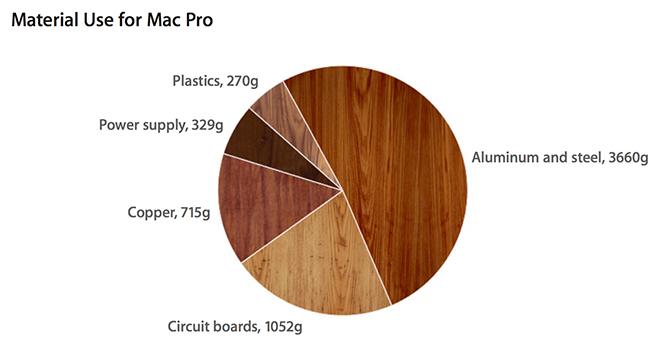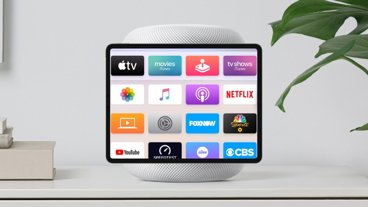Apple on Thursday released an environmental impact report regarding the company's latest Mac Pro desktop, noting the cylindrical machine uses 74 percent less aluminum than its predecessor, while keeping greenhouse gas emissions low.
The document, published to Apple's Environmental Reports webpage, breaks down the percentage of material used to build and package the Mac Pro, as well as the amount of energy consumed by shipping and predicted consumer use over the computer's lifetime.
According to Apple, the Mac Pro was designed to help minimize the machine's footprint and therefore materials used. The company points out that aluminum and copper, two of the most-used metals in the Mac Pro's build, are highly desired by recyclers. Compared to the old boxy Mac Pro, the black cylinder consumes 74 percent less aluminum and steel.
To maximize shipping efficiency, the company cut down on packaging, using corrugated cardboard made with a minimum 33 percent recycled content. In comparison with the legacy Mac Pro's package, the new version consumer 82 percent less volume. Compared to the old tower, the new Mac Pro can fit three times as many retail packages into an airline container.
As for energy efficiency, the Mac Pro incorporates intelligent components that are able to power down during periods of inactivity, thereby cutting down on estimated greenhouse gas emissions. Meeting ENERGY STAR requirements, the new professional desktop consumes 68 percent less power while idling than the previous Mac Pro.Total greenhouse gas emissions are pegged at 940 kilograms carbon dioxide equivalent, 65 percent of which comes from production, 33 percent from consumer use and one percent each for shipping and recycling.
Finally, as with most Apple devices, the new Mac Pro complies with various governmental best-practice guidelines such as the RoHS Directive, which restricts the use of lead, mercury, cadmium, hexavalent chromium, PBB and PBDE. Apple goes further by incorporating designs that are BFR-free, include PVC-free internal cables and offer PVC-free power cords in all regions except India and South Korea.
 AppleInsider Staff
AppleInsider Staff







 Charles Martin
Charles Martin


 Wesley Hilliard
Wesley Hilliard
 Stephen Silver
Stephen Silver
 William Gallagher
William Gallagher

 Marko Zivkovic
Marko Zivkovic







32 Comments
Why Apple ships power chords with PVC to India ? I can understand South Corea, but India ?
So we have this attitude from Apple, and yet, people still think Apple is going to start loading up cargo planes with cardboard boxes in sizes at: 60"- 110lbs, 55"- 100lbs 42"- 85lbs 37"- 60lbs
[quote name="BobSchlob" url="/t/161423/apple-touts-energy-material-efficiency-in-mac-pro-environmental-report#post_2452644"]So we have this attitude from Apple, and yet, people still think Apple is going to start loading up cargo planes with cardboard boxes in sizes at: 60"- 110lbs, 55"- 100lbs 42"- 85lbs 37"- 60lbs[/quote] So any company that makes TVs doesn't care about the environment? :???:
1) I'm not a fan of this wood image. 2) The graph is not accurate for the values given. 3) Here is the graph with the given values represented accurately (as well as my quick-and-dirty design using images that correspond to the various items for no other reason than to not use wood). [IMG ALT=""]http://forums.appleinsider.com/content/type/61/id/36828/width/350/height/700[/IMG] [quote name="BobSchlob" url="/t/161423/apple-touts-energy-material-efficiency-in-mac-pro-environmental-report#post_2452644"]So we have this attitude from Apple, and yet, people still think Apple is going to start loading up cargo planes with cardboard boxes in sizes at: 60"- 110lbs, 55"- 100lbs 42"- 85lbs 37"- 60lbs[/quote] I see your point, but I wouldn't expect them to use anything but modern ultra-slim display technologies which reduces the weight considerably… assuming they would create a TV at all.
[quote name="BobSchlob" url="/t/161423/apple-touts-energy-material-efficiency-in-mac-pro-environmental-report#post_2452644"]So we have this attitude from Apple, and yet, people still think Apple is going to start loading up cargo planes with cardboard boxes in sizes at: 60"- 110lbs, 55"- 100lbs 42"- 85lbs 37"- 60lbs[/quote] Interesting thought, but I'm sure the perspective will be they are x% more efficient than competing brands and include 100% less suck.